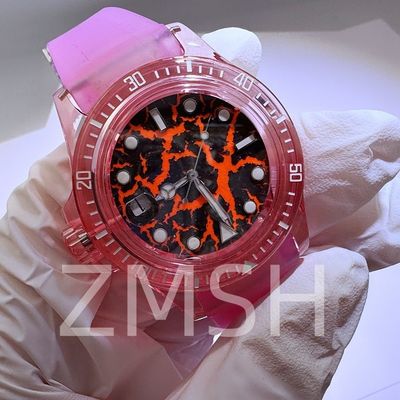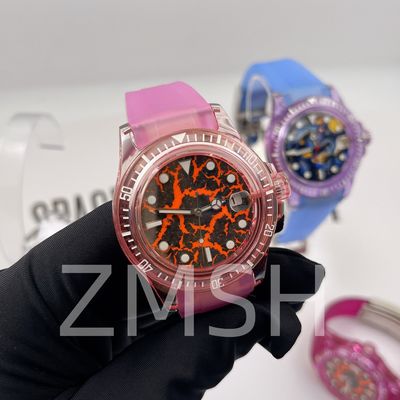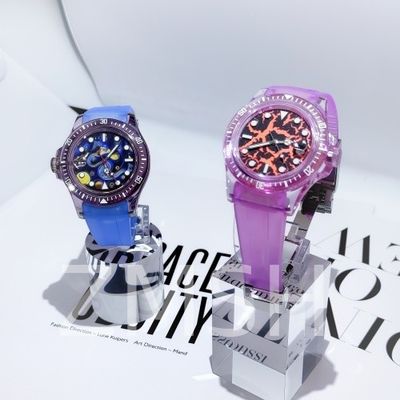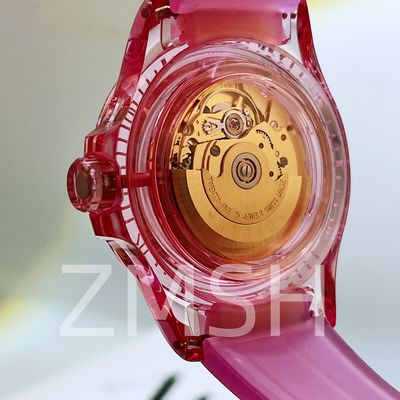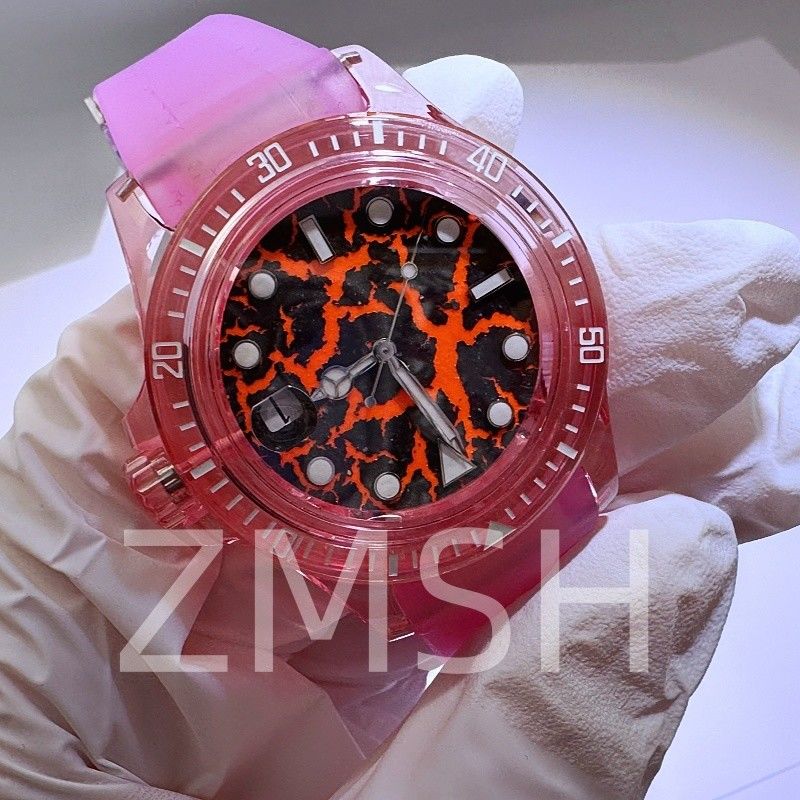Lab-Grown Sakura Pink Sapphire Watch Case
Dettagli:
| Place of Origin: | China |
| Marca: | ZMSH |
Termini di pagamento e spedizione:
| Minimum Order Quantity: | 2 |
|---|---|
| Delivery Time: | 2-3 weeks |
| Payment Terms: | T/T |
|
Informazioni dettagliate |
Descrizione di prodotto
1. Product Overview
The Lab-Grown Sakura Pink Sapphire Watch Case is a cutting-edge creation that blends the brilliance of synthetic gemstone technology with modern horological design. Made from high-purity single-crystal sapphire (Al₂O₃), this watch case offers exceptional hardness, excellent transparency, high wear resistance, and lasting aesthetic appeal. What makes it particularly unique is its sakura pink hue, a soft, radiant tone inspired by cherry blossoms and achieved through precise doping of chromium (Cr) and titanium (Ti) during the crystal growth phase.
This sapphire watch case is not merely a fashion statement — it is a technological marvel. With a Mohs hardness of 9, it is virtually scratch-proof under everyday use and maintains its clarity and brilliance over time. It is ideal for premium watch brands looking to differentiate through innovation, color, and performance.
The sakura pink sapphire case adds a warm, feminine, and modern flair to timepieces, making it particularly popular in limited edition models, luxury sports watches, and designer collections.
![]()
![]()
2. Sapphire Watch Case Manufacturing Principles
The production of a lab-grown sapphire watch case involves a complex yet precisely controlled multi-step process:
a. Crystal Growth
The base material is single-crystal sapphire, grown using one of the following methods:
-
Verneuil (Flame Fusion) Method: A rapid, cost-effective technique using aluminum oxide powder melted by an oxyhydrogen flame, forming a boule on a rotating pedestal.
-
Kyropoulos or Czochralski Method: Used for growing larger, more uniform boules with better control over internal defects and color distribution.
In both methods, chromium and titanium dopants are introduced in trace amounts to achieve the desired pink hue. The resulting crystal is optically pure and chemically stable.
b. Precision Machining
The grown crystal boule is cut into manageable blocks and subjected to CNC machining using diamond-coated tools. Key processes include:
-
Shaping: Lathe cutting the crystal into precise watch case shapes.
-
Drilling: Creating openings for the crown, buttons, and movement housing.
-
Polishing: Multi-stage fine polishing ensures optical clarity and surface smoothness on both inner and outer faces.
Due to sapphire’s extreme hardness, machining is time-consuming and must be done with specialized tools and coolants to avoid thermal stress or microfractures.
c. Assembly and Heat Treatment
The machined components undergo thermal annealing to relieve internal stress, followed by ultrasonic cleaning. Components are then assembled using precision tools, sometimes combined with metal inserts or gaskets, depending on the watch design.
The final product combines artistic elegance with industrial durability — every piece is the result of hundreds of hours of engineering and finishing work.
3. Sapphire Specification Sheet
| Parameter | Description |
|---|---|
| Chemical Formula | Al₂O₃ (Purity ≥ 99.99%) |
| Crystal Structure | Trigonal (Hexagonal system), Space group R-3c |
| Crystal Orientation | C-plane (0001), A-plane (11-20), R-plane (1-102), M-plane (10-10), customizable |
| Color | Colorless, blue, pink, yellow, green, purple (controlled by dopants like Ti, Fe, Cr, Ni, etc.) |
| Transparency | Transparent to translucent (industrial: full transparency; gem: eye-clean clarity preferred) |
| Refractive Index | 1.762 – 1.770 |
| Birefringence | ~0.008 |
| Density / Specific Gravity | 3.95 – 4.00 g/cm³ |
| Mohs Hardness | 9 (second only to diamond) |
| Dispersion | 0.018 (low fire; not as sparkly as diamond) |
| Thermal Conductivity | ~35 W/m·K @ 300K |
| Melting Point | ~2050°C |
| Thermal Expansion Coefficient | ~5.0 × 10⁻⁶ /K (along C-axis) |
| Optical Transmission Range | 150 nm – 5500 nm (deep UV to mid-IR) |
| Electrical Resistivity | >10¹⁴ Ω·cm (excellent electrical insulator) |
| Luster | Vitreous (glass-like) |
| Inclusions | Typically minimal; curved striae and gas bubbles may be present (identification clue) |
| Fluorescence (UV) | Usually none, though pink/orange stones may show slight fluorescence under short-wave UV |
| Available Shapes | Rods, wafers, cylinders, domes, round plates, lenses, cubes, prisms, gemstones |
| Common Sizes | From 2 mm up to 300 mm diameter for industrial applications |
| Surface Finish | Optical polish (Ra < 1 nm), ground (Ra < 1 μm) |
| Growth Methods | Verneuil (Flame Fusion), Kyropoulos (KY), Czochralski (CZ), EFG, HEM |
| Applications | Watches, optical windows, IR sensors, LED substrates, smartphone lenses, jewelry, laser systems |
| Stability | High resistance to thermal shock, corrosion, and chemical attack |
| Durability | Excellent for harsh environments (mechanical, thermal, chemical) |
4. Applications of Sapphire in the Jewelry & Watch Industry
Sapphire has become a cornerstone material in high-end jewelry and horology due to its exceptional optical, mechanical, and chemical properties.
a. Watchmaking
-
Watch Cases: Increasingly adopted by luxury watchmakers (e.g., Richard Mille, Bell & Ross) for its transparency, color variability, and durability.
-
Crystal Windows: Synthetic sapphire is the standard for watch face crystals due to its scratch resistance.
-
Casebacks: Transparent sapphire backplates allow viewing of complex watch movements.
b. Jewelry
-
Colored Gemstones: Lab-grown sapphires are widely used as substitutes for natural rubies, sapphires, and fancy-colored gems.
-
Custom Accessories: Fashion rings, earrings, and pendants often feature colored sapphire due to its affordability and aesthetic variety.
-
Luxury Smart Devices: Premium smartwatches, fitness bands, and wearables incorporate sapphire screens for their toughness and clarity.
c. Beyond Jewelry
-
Optical Windows & Lenses: Used in scientific instruments and high-energy laser systems.
-
Luxury Consumer Electronics: Sapphire buttons, camera covers, and biometric scanners.
The adaptability and prestige of sapphire make it one of the most sought-after synthetic materials in fashion and function.
5. FAQ – Frequently Asked Questions About Sapphire Watch Cases
Q1: Is sapphire really that scratch-resistant?
A: Yes. Sapphire is rated 9 on the Mohs hardness scale, second only to diamond (10). It is nearly impossible to scratch with ordinary materials like keys, coins, or sand. This makes it ideal for watch cases and crystals that must endure daily wear.
Q2: Will the sakura pink color fade over time?
A: No. The color is created by atomic-level doping of transition metals into the sapphire crystal lattice. It does not fade, discolor, or degrade under UV exposure, heat, or normal chemical contact.
Q3: What’s the difference between lab-grown and natural sapphire?
A: Chemically and physically, they are virtually identical. The primary difference is origin — lab-grown sapphire is created in a controlled environment, free of inclusions or impurities, making it more uniform and cost-effective than natural sapphire.
Related products
Thickness 3.75mm Sapphire Crystal Watch Case Blue 9H High Hardness Abrasion Resistance
![]()
Pink Blue Color Sapphire Crystal Watch Glass Replacement Customized Size



